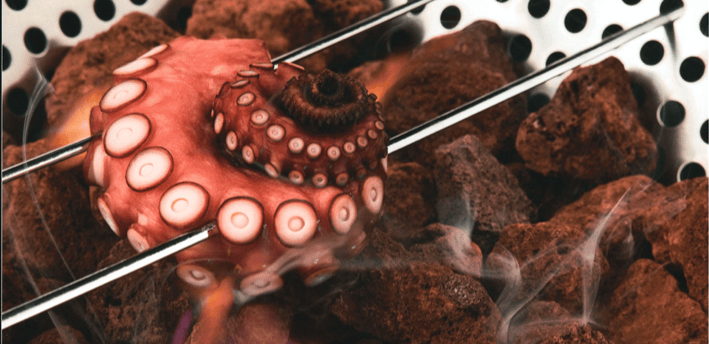Blanching and searing for sous vide
Culinary Precision: The Science of Sous Vide and Culinary Techniques Delve into the science of sous vide cooking and the practical applications of blanching and searing for impeccable, flavorful dishes that captivate both the palate and the eye.
COOKING SOUS VIDE
Francesco Feston
10/13/20233 min read


Sous vide cooking consistently delivers delicious food, but the appearance of the food post-cooking may not always meet expectations. Most people anticipate their beef steaks to have a brown exterior, as opposed to appearing pink or gray. Grill marks on a fish steak provide an enticing visual element, while the skin on a duck breast is at its best when it's crispy. Unfortunately, these culinary effects are unattainable through sous vide cooking alone.
You should also please the eye
Fortunately, there is a straightforward approach to enjoy the best of both worlds: combining sous vide cooking with traditional methods like blanching and searing. These techniques serve purposes beyond enhancing the food's aesthetics. Both blanching and searing effectively cleanse the surface of the food, and they also help solidify tender meats and seafood, ensuring they maintain their shape when vacuum-sealed. It's worth noting that blanching and searing are not always interchangeable. Blanching must be performed before sous vide cooking, while searing can be done before, after, or both.
Blanching involves either steam or a quick dip in very hot water to prepare the food. To avoid overcooking during blanching, it's advisable to use water as hot as possible, which might seem counterintuitive, but it's true because heat requires time to penetrate food. Higher temperatures mean shorter exposure to water or steam is needed for surface sanitation and less heat penetration into the food. For instance, water at 70°C (158°F) requires about 10 seconds to sterilize the food's surface, whereas water at 76°C (168°F) accomplishes the same in just one second. Using high-temperature steam or boiling water is particularly crucial when blanching fruits and vegetables to swiftly eliminate enzymes. While some enzymes contribute desirable flavors, many others degrade produce during storage and cooking.
How to keep pigments in good shape
In green vegetables, chlorophyllase gradually transforms green chlorophyll into olive-brown pheophytin pigments. In numerous fruits and vegetables, such as apples, artichokes, and potatoes, polyphenol oxidase responds to tissue damage similarly to how our skin tans after sunburn, catalyzing the production of protective deep-brown melanoidin pigments. Vacuum and modified-atmosphere packing can slow down these enzymes, but a sufficiently long blanching can completely destroy both polyphenol oxidase and chlorophyllase, thus preserving the fresh color of fruits and vegetables more effectively.
For most fruits and vegetables, blanching at a full rolling boil is typically preferable over steam blanching or simmering because it elevates the temperature more rapidly. Swiftly raising the core temperature to the boiling point is essential, as a temperature of 100°C (212°F) can eliminate 90% of polyphenol oxidase enzymes in just two seconds, whereas achieving the same level of enzyme destruction takes approximately two minutes at the slightly cooler temperature of 90°C (194°F).
Tip:
Quickly searing a steak on a plancha after cooking it in a water bath creates the mouth-watering aromas of charred meat while preserving the tenderness and juiciness that are hallmarks of sous vide cooking.
Searing Before Vacuum Packing
Sometimes, pre-searing food before vacuum-sealing proves more effective than blanching. This is due to the intense heat of pre-searing, which initiates Maillard reactions, responsible for the flavors found in conventionally cooked dishes (refer to page 3-89). Maillard reactions require a minimum temperature of 130°C (266°F), well above that of a water bath. Once initiated, these reactions persist even if the temperature decreases, enriching the flavor of sous vide preparations. However, it's essential to avoid pre-searing for lamb, meats from grass-fed animals, and a few other items, as it may induce undesired reactions leading to off-flavors and reheated tastes when later cooked sous vide.
Pre-searing offers a convenient way to impart grill marks on fish or chicken before packaging, simplifying the reheating process for service. But when a crispy crust is crucial, pre-seared crusts need either post-sous-vide searing or another searing round after the package is opened because any crust formed during pre-searing softens during sous vide cooking.
For fatty meats like duck breast, a specialized pre-searing method called cryorendering (see page 3-124) can be incredibly valuable. The typical sous vide cooking temperatures for duck breasts often fall short of effectively rendering fat beneath the skin. Searing after cooking does render fat but risks overcooking the meat. Cryorendering, on the other hand, maximizes fat rendering by treating a near-frozen duck breast before vacuum-packing and cooking.
Critics of sous vide cooking have argued that it may not consistently replicate the colors, flavors, and textures achieved through traditional cooking methods, particularly with meats and seafood. The solution lies in searing ingredients after their sous vide preparation. Incorporating a final searing step into the sous vide process is straightforward and empowers cooks to mimic the external results of traditional cooking techniques while maintaining precise control over the internal cooking process. This hybrid cooking approach can create striking textural contrasts between a crispy exterior and tender interior.
Moreover, searing induces Maillard reactions and other chemical transformations exclusive to high temperatures. These reactions yield the distinct, irreplaceable flavors found in roast beef, grilled chicken, and pan-fried salmon. Sous vide cooking operates at lower temperatures to preserve moisture in meats and seafood, often missing out on these flavor-enhancing reactions. However, a well-considered post-sous-vide sear strikes a balance by browning the surface while minimally affecting the underlying flesh.
